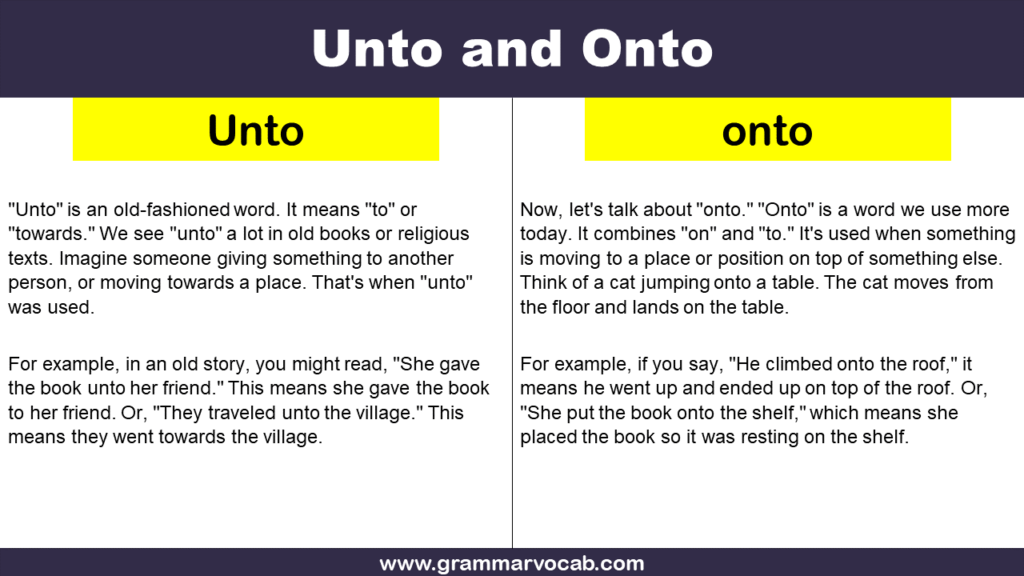When we speak or write in English, it’s important to use the right words. Two words that can be confusing are “unto” and “onto.” They may sound similar, but they have different meanings. Let’s make it easy to understand the difference between them.
What is “Unto”?
“Unto” is an old-fashioned word. It means “to” or “towards.” We see “unto” a lot in old books or religious texts. Imagine someone giving something to another person, or moving towards a place. That’s when “unto” was used.
For example, in an old story, you might read, “She gave the book unto her friend.” This means she gave the book to her friend. Or, “They traveled unto the village.” This means they went towards the village.
What is “Onto”?
Now, let’s talk about “onto.” “Onto” is a word we use more today. It combines “on” and “to.” It’s used when something is moving to a place or position on top of something else. Think of a cat jumping onto a table. The cat moves from the floor and lands on the table.
For example, if you say, “He climbed onto the roof,” it means he went up and ended up on top of the roof. Or, “She put the book onto the shelf,” which means she placed the book so it was resting on the shelf.
Unto Vs Onto
| Aspect | Unto | Onto |
| Basic Definition | An archaic or biblical term meaning ‘to’ or ‘towards’. | Refers to moving to a position on top of or above. |
| Usage | Often found in religious or historical texts. | Common in contemporary English. |
| Context | Used to indicate movement towards something or someone, often with a sense of purpose or end point. | Indicates the movement of something so it becomes atop or covering something else. |
| Example Sentences | “She gave her savings unto the charity.” | “The cat jumped onto the roof.” |
| Modern Replacement | In modern English, ‘unto’ is often replaced with ‘to’. | No direct replacement, ‘onto’ is specific in its meaning. |
| Prepositional Phrase | Often part of a phrase indicating motion towards a goal. | Usually indicates the end of a movement or action. |
| Figurative Use | Can be used figuratively, e.g., “devoting oneself unto a cause.” | Less likely to be used figuratively. |
Why the Confusion?
The confusion between “unto” and “onto” happens because they sound similar. But their meanings are different. Remember, “unto” is more about giving or going towards, and “onto” is about moving on top of something.
How to Remember the Difference
To remember the difference, think about what you’re talking about. If it’s about giving or doing something for someone, “unto” is your word. But if you’re talking about moving to a place or being on top of something, “onto” is the right choice.
Must Try:
Difference Between Tale and Tail
Necessary or Necessarily
Club vs Bar




